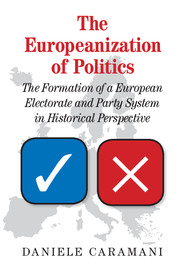 The Europeanization of Politics
The Europeanization of Politics Book contents
- Frontmatter
- Contents
- List of Figures
- List of Tables
- Preface and Acknowledgements
- List of Abbreviations
- Introduction: Electoral Integration in Europe
- Part I Framework
- Part II Analysis
- Part III Assessment
- 8 Sources of Europeanization: Supra-, Within-, and Trans-national Explanations
- Conclusion: Towards Europe-wide Representation
- Appendices
- References
- Index
8 - Sources of Europeanization: Supra-, Within-, and Trans-national Explanations
from Part III - Assessment
Published online by Cambridge University Press: 05 November 2015
- Frontmatter
- Contents
- List of Figures
- List of Tables
- Preface and Acknowledgements
- List of Abbreviations
- Introduction: Electoral Integration in Europe
- Part I Framework
- Part II Analysis
- Part III Assessment
- 8 Sources of Europeanization: Supra-, Within-, and Trans-national Explanations
- Conclusion: Towards Europe-wide Representation
- Appendices
- References
- Index
Summary
Introduction
Empirical evidence presented in the five chapters of Part II provides ample support for the thesis of the Europeanization of politics. The crucial phases in the late 19th and early 20th centuries of the formation of party systems witness steady homogenization processes and simultaneous waves of change across the continent – in both Western and Central-Eastern Europe. Similar alignments are put in place which – in the past 30 years – have also permeated the EP. The ideological cohesiveness within Europe-wide party families has been high since World War II and it is likely that this indicator, too, has its roots in early periods of party systems’ formation. Executive politics has undergone cross-national convergence under the impact of the recent events of European integration and the end of the Cold War.
The main line of interpretation that transpires through the evidence points to the role of the left, that is the role of socialists and social democrats: “class politics” and the left–right cleavage. This is the dimension that, by structuring national party systems, is the fundamental feature of their similarity. Its emergence in the late 19th century represents the main swing which, up to the present time, has remained unparalleled. In its wake territorially differentiating factors of a cultural nature and pre-industrial age are replaced by a functional alignment cutting across territories. Social democrats appear as the most integrated party family and it is their ideological shift in the early 1990s that causes the convergence of cabinet politics. Europeanization is to a large extent the story of the left and its relationship to the market economy.
The goal of this chapter is to investigate more systematically the sources of Europeanization along the explanatory scheme sketched in Chapter 1.
- Type
- Chapter
- Information
- The Europeanization of PoliticsThe Formation of a European Electorate and Party System in Historical Perspective, pp. 255 - 283Publisher: Cambridge University PressPrint publication year: 2015


